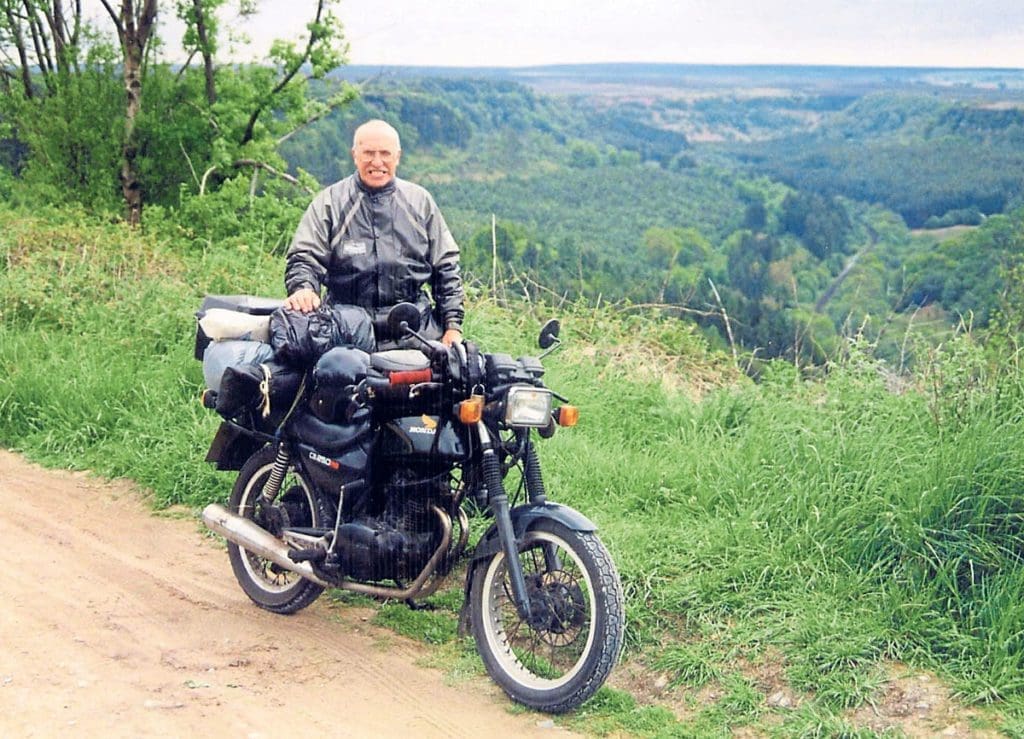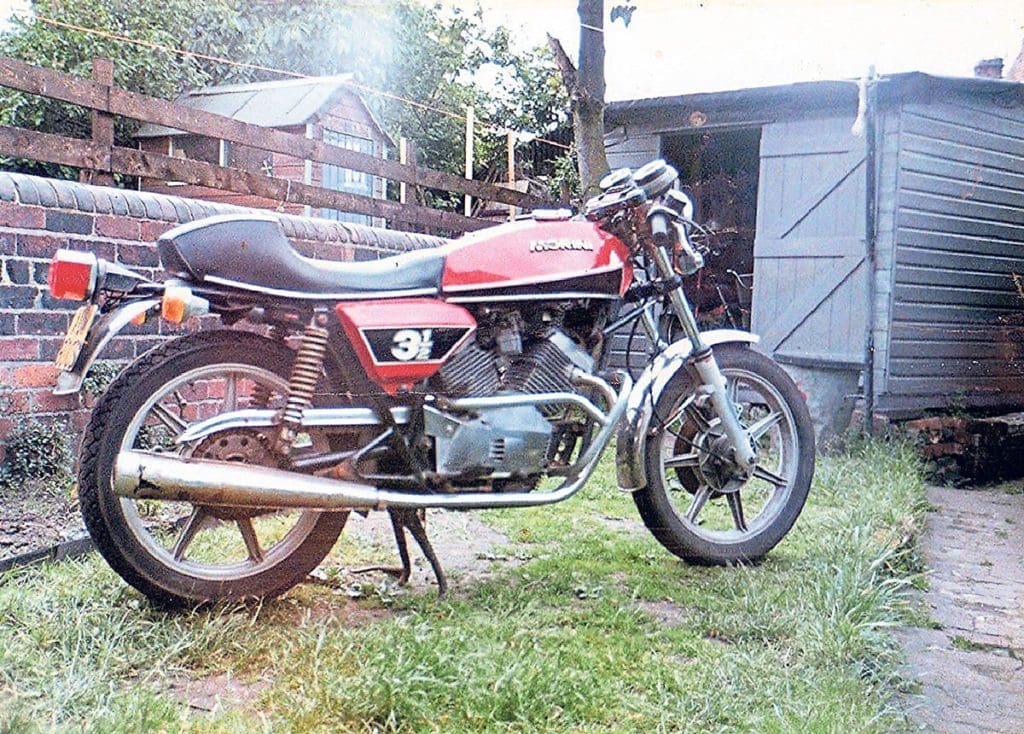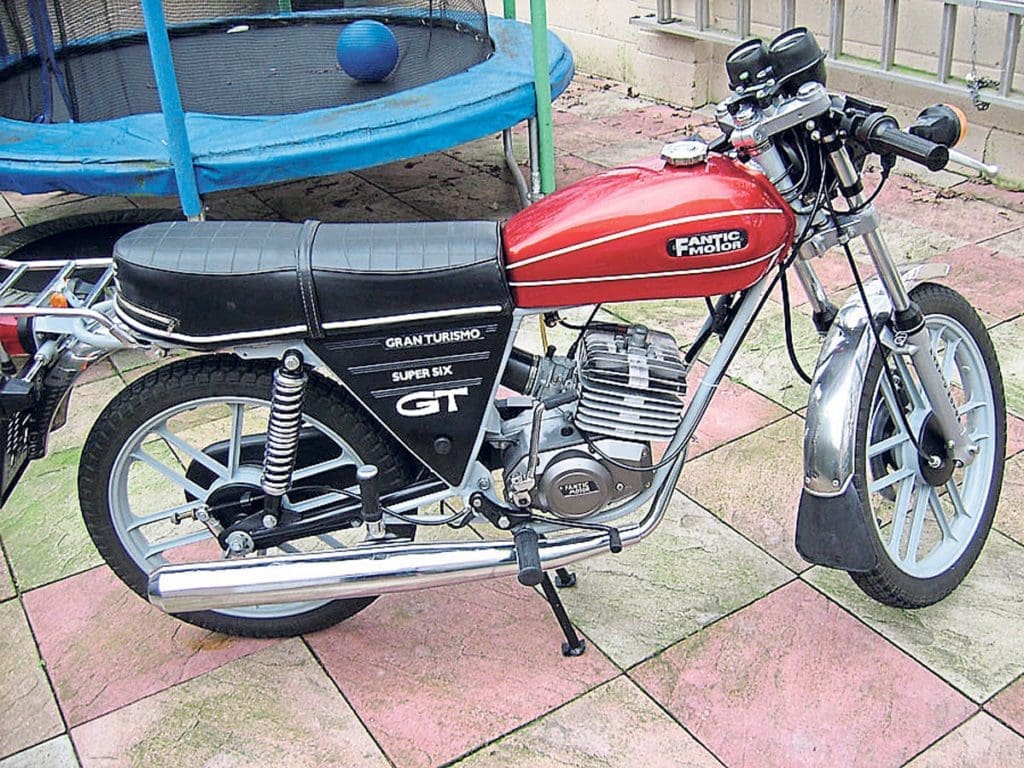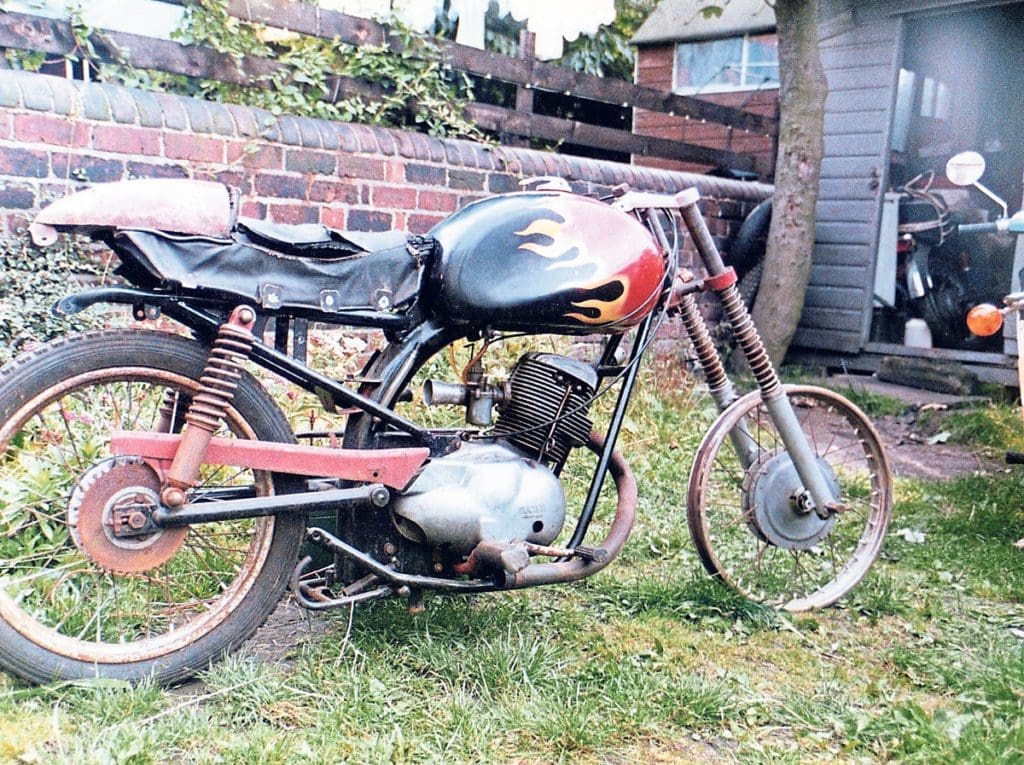Over the years John Askham has owned what he himself calls a load of ‘old nails’. Here he remembers just a few of them.

The first motorcycle I ever owned was an Excelsior Talisman Twin. This was the first in a long line of old nails that passed through my hands. Some were better than this, many weren’t.
This little machine was bought from one of my biking friends, Roy. It had dropped bars and a wooden mock-up of a racing seat. When it was a runner it had a reasonable turn of speed, but mostly it only ran on one cylinder. This was because the crank, which was a built-up arrangement, kept breaking the Woodruff key that held it all together. In hindsight, I suppose that it was the taper that kept the crank together that was at fault. the Woodruff key was just to get the correct alignment. After the third engine rebuild Roy gave me back the £15 I had paid him for it.
Enjoy more Old Bike Mart reading every month.
Click here to subscribe & save.
Soon, with a loan from a favourite uncle, I was the proud owner of a Royal Enfield Crusader. This great little motorcycle served me well for nearly three years, until the end of 1963 – New Year’s Eve, to be exact. A car pulled out in front of me as I was riding to work. Concussed and minus three teeth, along with a badly split lip, I signed myself out of hospital. The Enfield fared worse. Bent forks, bent frame and a crack in the crankcase meant that this bike had had its day. But wait… With a new set of forks, and if I replaced all of the parts that I had taken off in order to lighten the bike (i.e., headlamp nacelle, toolboxes), it might just make it back on to the road. So, that was the plan.
In the meantime, while I was waiting for new fork legs, Roy once again came to the rescue. He loaned me a Royal Enfield Flying Flea which was a real nail. It had a single saddle with loose cover, minimal lights, bulb horn and a hand-change gearbox. The ignition was so far worn that it was possible to get the engine to run backwards – we had loads of fun riding it backwards around the underground bike park where we worked.
Then, with the arrival of the fork legs, I reassembled the Crusader with all of the factory parts. It looked great. But I knew otherwise. So, early March saw me at the local Wragg’s motorcycle emporium doing an exchange deal on a brand new black and chrome Honda CB250 Sports. It was a beauty. But, after a disastrous trip to the TT it had to go. It was extremely fast, but it didn’t handle. Two ‘offs’ on the Island meant a wobbly ride home and it was sold for £100 less than I had paid for it.

The Honda cost me £260 in 1964. For just £10 more, I could have bought a 650 Triumph Trophy.
But I had my eye on a Norton Dominator 500SS. This was a very nice bike; the crank had been balanced at Bracebridge Street which made for a very smooth engine. I paid £95 and it served me well for a few years, including trips to the TT and our honeymoon to Wales (a sidecar was fitted for this trip).
The collecting begins!
One month after my marriage to Ann in 1966, we moved into the house where we still live. This is when I started to collect all kinds of motorcycles and various parts. I do remember buying a Matchless 500 twin. I cannot recollect what year the bike was, but it did have ‘jampot’ suspension, so it must have been mid-1950s at least. I paid the princely sum of £2 for it. Yes, two pounds. The engine would run, but there was no power at all. With my meagre knowledge of Matchless motorcycles, I quickly passed this bike on. I didn’t do badly though – the new owner paid me £8 for it. I never saw the bike again, so I don’t know if it was made into a good one.

I then acquired a Villiers in semi-trials trim. This had a 197cc engine which, once again, was a real mess; no compression, no exhaust, no mudguards. Once again, this machine got its marching orders and I gave it away. Then along came a pair of engines, a Royal Enfield 500 twin and a Triumph Tiger 70. Both of these had big end problems, but I actually got hard cash when they departed. This gathering of useless bits of motorcycles came to an end when I came across an ex-Army 350 Matchless. This was a runner but, alas, it was stolen, never to be seen again.
I must add that the house where I was living, and still do, is a terraced house with no front garden and limited access to the rear, so it’s very hard to get any kind of motorcycle round the back. I vowed never to buy any more junk again. This soon ended when I was offered a Norton 19S with Hillsborough sidecar for £8. I had loads of fun with this and I just loved the big single which pulled the heavy sidecar with no trouble at all. I was still running my 600 Dommie, so just swapping the number plate around was the way to go. Eventually the sidecar was taken off and sold for a fiver. The big single was used daily for a few months and eventually sold for £10 after having my arm twisted.
However, now with a baby daughter, I had other considerations, My back garden had to stop looking like a breaker’s yard. So I had a Royal Enfield 700cc Constellation with a double adult chair. This was used to attend the 1970 TT races, but all I can recall of that episode is that the rear wheel spokes couldn’t stand the strain and most of the week in the Island was spent rebuilding the wheel. Our good friends Dave and Pearl kindly ferried us around in their Ford Granada. I parted with this outfit in order to buy my first car.
I then unearthed a basket case Norton 650SS for which I paid £60 and which was finally put together in time for the TT in 1978! In 1974 I was employed by good old British Rail as a guard on freight trains. Lots of work was to and from the steelworks and various metal recycling businesses. While waiting for wagons to be loaded, I sometimes had time to wander round the yards. It was a great place to pick up useful bits and pieces – things like a complete Honda 125, Norton Dommie engine and gearbox, Dunlop WM2 alloy rim and a Panther chassis complete with wheel and mudguard. The Honda I tarted up and sold for £75. The Norton parts were used for spares and the Dunlop rim and the Panther chassis were advertised in MCN. A punter came all the way up from Cardiff to part with £25 for the rim, and a pest control worker on his way home to the North East made room for the Panther chassis in his van. This too made £25.
At the scrap yard, I would put all these parts into my double adult sidecar. The little Honda went in without too much trouble, but I had to wheel the Panther chassis home. This was a real pain, as I had to balance the chassis by putting the large front fitting on my shoulder and pushing it along on one wheel.
A Blue Star in a coal shed
In the mid-1980s I bought my Moto Morini 3½ for a penny less than £100. This was via a workmate on the railway and is an ongoing project. Also through a work colleague I heard of a BSA rusting away in a back garden. It took months for me to get enough info off him to be able to locate just where it was. Eventually I knocked upon the right door. I had visions of maybe a Gold Star, or a 650 Rocket but the chap that answered told me that it was a Blue Star. I had never heard of this model although he assured me that it was the sports bike of its day. He took me to the coal shed and there it was, just an engine covered in coal dust. What a disappointment. Nevertheless, I paid him the £10 he wanted and loaded up the car with one complete single cylinder 500cc engine, spare barrel and piston, pair of high level exhaust pipes, two gearboxes, one with foot change conversion. He even threw in a Villiers engine. The frame and forks were doing sterling service in supporting the hedge so I left them there.

On the way home I visited ‘Scott Road’ where I offloaded the Villiers engine for two quid. (Scott Road was just a big house in the middle of a housing estate where two brothers ran a gold mine of a backstreet motorcycle business which is worthy of a tale on its own.) The Blue Star engine was examined and found to be in real good condition once the coal dust had been cleaned off. The crank was perfect and turned easily. Even a little shine was showing on the exhausts. So, it was all boxed up until I decided what to do with it.
Then, as I was perusing the pages of MCN, there it was. Somebody was actually advertising for a carburettor for a Blue Star. Immediately I rummaged in the box of spares and found the item which had just one letter different at the end of the serial number. Straight away I phoned the chap who was overjoyed and asked if I had any other bits. You bet I did. I told him he could have the lot for £50. When he arrived, he was wearing a navy blue blazer with the BSA crest on the pocket and pale grey slacks and had a car full of wife, two kids and holiday gear. They were off to South Wales from Essex, via my house in Sheffield. Keen indeed. He stowed the scruffy box of engine bits into the back of a Ford Granada estate and then insisted on me taking him to the house in Rotherham to inspect the rest of the BSA. It was just like an archaeological dig. There he was in his smart slacks, digging away in the grass looking for any bits that might have escaped. The frame was completely rusted away, but the forks and front downtube were salvaged, as were bits of chain and gear linkage. He was highly delighted – so much so, that he gave the man £20. I then realised that he’d had a great bargain from me. But this didn’t bother me in the least; I knew that he was a real enthusiast. After being fed and watered by my good wife, they went on their way, car down on its springs, he with dirty knees and a great big smile.
By the mid-1980s I was renting a lock-up garage. In this garage I counted at one time 10 motorcycles; where they all came from now escapes me. Among them were a couple of rather decent bikes such as a Honda CG125 for which I paid £10. This was a non-runner and was scruffy but it wanted no more than a good fettle, oil change, new plug, etc. This, I sold for £135. I was turning into a right old Arthur Daley. The other good bike was a 50cc Fantic which looked great, all blue and chrome with mag-style wheels, duplex frame and a six-speed gearbox. I forget how much I paid for this one, but a buyer couldn’t wait to give me £150 for it. Lovely jubbly!
I also came across a Honda RSA250 for £50. This bike I kept and rode for quite a few years, doing many camping trips, loaded up to the hilt, and it never complained. The Honda kept company with a Honda 70 step-through which was my commuting machine. I also remember being given a Yamaha 80 step-through. This had broken down in the middle of Sheffield and all I had to do was to collect it. Easy peasy? No. The Yamaha was leaning against a building directly outside the Crucible Theatre. It looked okay but on closer inspection it was found to have a collapsed swinging arm. Nevertheless, into the back of my van it went. It looked for the entire world that I was stealing the bike although no one challenged me, which was a relief. I rebuilt the swinging arm and put the bike back on the road. This made a great little runner. The engine just purred and the chap that I sold this to used it until his retirement.
While visiting a friend of mine, only a stone’s throw away from home, I noticed a black lump sticking up out of the long grass of a neighbour’s house. On investigation this lump turned out to be a Honda CB750 F2 engine. Complete. A knock on the door, and the lady told me to take the lot. Her son had taken off somewhere and the frame, saddle and wheels were also slowly rusting in the cellar. This engine gave me plenty of good spares.

The Yamaha that nearly killed us
After this episode, things slowed down. Then, in the late-80s, a good friend of mine told me of a sidecar combination that was gathering muck and rust. I went to investigate. There it was, outside and completely uncovered. It was a Yamaha 500 twin with a Squire chair. The hood had gone green with mould but otherwise it was complete. I soon returned with a couple of hundred quid in my pocket. I didn’t take a penny extra – this was to be my limit. The lady of the house answered the door. After stating what I had come for, and how much I was offering, the husband sniffing some ready cash, came to the door. He tried to up the ante, by saying he planned to refurbish it, but his wife stepped in saying: “That’s all rubbish, give me the £200 and it’s yours.” I sold the sidecar for £150 and kept the Yamaha which even took the wife and me to the Manx Grand Prix although it nearly caused the death of us both.
En route to Liverpool for the 20.00 sailing to Douglas, we were on the M62 to Liverpool where roadworks on the outside lane meant that all traffic was moved over, so that the hard shoulder was effectively the ‘slow’ lane and there was no hard shoulder. We were running with the heavy traffic at about 55mph in the middle lane when suddenly the rear tyre blew. Ann on pillion grabbed me tight. A split-second decision had to be made. There was just a car’s length space to the outside of us. I dived into the gap and then skittled a traffic cone out of the way as I made for the coned-off section. Lots of sounding of horns ensued, but we were in the safety of the cones. The river of traffic carried on just as though nothing had happened. Loaded up as we were, we were lucky that we made it.
For once I had a spare tube in my kit and all the tools – except a pump. What to do? I proceeded to replace the tube when the endless flow of traffic sped past. Then I waited until finally a police car stopped at the far side of the motorway. He then dashed across the traffic to tell me that a recovery truck was coming which duly arrived, being skilfully manoeuvred from the nearside lane across the traffic until it was our side of the cones. The driver then loaded us on to the truck.
The recovery truck driver’s remit was only to take us off the motorway. But, upon hearing our story, he took us to the compound where there was an air line. This did the job fine and we then carried on to Liverpool. We arrived just in time to see the Manx ferry disappearing down the Mersey. We had missed it by about 10 minutes. After telling of our woes at the ticket office, it was understood that we could use the tickets the next day up at Heysham. We rode up to Morecambe, where we stayed the night and sailed the next day.
Much later, I read a road test of the Yamaha. In the report it stated that the way the bike was balanced put too much weight on the rear of the bike resulting in extreme tyre wear. It made me think, had I overloaded the Yamaha with wife and a week’s luggage? I’ll never know. The Yamaha was soon on its way. Another nail gone, but I was £350 in pocket.
In my possession, I had a Rickman swinging arm. Where I got it from escapes me. What didn’t escape me, though, was the offer I had to do a swap for a Ducati 125. This was too good to refuse. So I became the owner of my second Italian motorcycle. Although it was a basket case I had the best of the bargain and I did hear the engine run before I closed the deal. What I didn’t know was that the forks were off a much later model and any parts for this motorcycle, which was a TV model, were almost impossible to find. I never did get around to doing anything with this tiny bike and I eventually sold it for £100 – I do hope the guy that took it on has made a good bike out of it. Was this a nail? I suppose that if I had the enthusiasm and cash to renovate this bike it would have been a great attraction at local shows.
So, that’s about it. Plenty of nails in there, but also quite a few decent bikes. The Norton 19S is the one I wish that I had kept.




